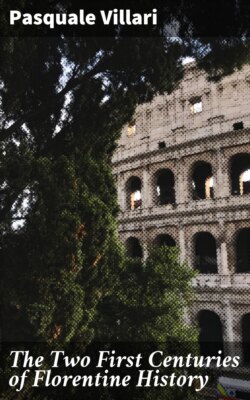Читать книгу The Two First Centuries of Florentine History - Pasquale Villari - Страница 21
На сайте Литреса книга снята с продажи.
IX.
ОглавлениеTable of Contents
Attention should now be called to the popular element in the constitution. That the guilds were solidly established by the early part of the twelfth century is indubitably proved. Villani says that towards the year 1150 the Consuls of the Merchants, or rather of the "Calimala Guild," were entrusted by the Commune of Florence with the building works of "San Giovanni" (i. 60). Of still greater significance is the fact that on February 3, 1182, the men of Empoli, in making submission to Florence, were bound to make a yearly payment of fifty pounds of "good money" (buoni denari) to the Consuls or Rectors of the city, and, failing these officials, to the Consuls of the Merchants,135 as representing the Commune. Now, if these Consuls had reached so high a degree of importance in 1182, we are entitled to believe that the guild was of no recent origin. And remembering that the guild in question was the Calimala—i.e., that of finishers and dyers of woollen cloths manufactured abroad, and more especially in Flanders, imported by Florence, and thence despatched to foreign markets—we shall understand that Florentine commerce must have already attained a prodigious development, and consequently that many of the guilds must have been already long established. A solitary instance would naturally afford little proof, since it might be open to various interpretations; but others can be adduced to the same effect. In a treaty between Lucca and Florence of July 21, 1184, we find a stipulation according to which the terms might be modified by the Florentine Consuls comuni populo electi, and by twenty-five counsellors, provided, as was expressly declared, the Consuls of the merchants were comprised in the number.136 Likewise, when the men of Trebbio made submission on July 14, 1193, the power of incorporating the agreement in the City Statutes was exclusively reserved to the seven Rectores qui sunt super Capitibus Artium.137
But a final observation occurs to us at this point, again showing the very uncertain and changeable nature of this consular government. In mentioning the chief authorities of the Commune, almost all documents refer to them as "Consules seu rectores vel rector," with the addition, at a later date, of "Potestas sive dominator."138 All these terms had a very general meaning at the period. Nevertheless, there must have been some reason for employing the formula—Consuls or Rectors or Potestà—in treaties of peace, or alliance, or state documents of high importance; and probably a special reason, seeing that we often find the formula ending as follows: "Consules qui pro tempore erint, et si non erint," the Rectors or the Potestà or the Consuls of the guilds were to act in their stead. Why so much vagueness in indicating the chief magistrate of the Republic? Only one explanation is possible. The real practical government of the city was carried on by the various associations; the office of Consul had few attributes and never attained the power and importance due to a central government, as conceived in the modern sense. The same remark may be also applied to the Priors, the Ancients, and other officers of later date; but it is specially true as applied to the consuls, under whom the various civic societies were first united in a single government. Therefore, to meet the eventuality of no Consuls being in office at the moment, it was provided that the Rectors of the Towers or of the guilds should naturally assume the power directly emanating from them. But as no public acts performed in the name of the Rectors are extant, we may conclude that the contingency arranged for seldom arose.
Frequent mention occurs of counsellors (consilarii), and we note that representatives of the guilds were comprised among them. We know, in fact, that there was a council in Florence, as in other Italian communes, and Villani tells us (iv. 7, and v. 32) that this council was called a senate "according to the custom given by the Romans to the Florentines," and composed of one hundred worthies (Buoni Uomini). In documents, however, they are nearly always entitled consiliarii, the term "senator"139 only occurring once; but in those days the term senato or consiglio, senatori or consiglieri, were often indiscriminately applied, particularly with regard to the limited or Special Council, as it was afterwards called. No documents supply us with the precise number of the councillors; but we believe the one hundred recorded by Villani must be somewhat under the exact figure, since a form of oath sworn by 133 councillors is extant.140 Perhaps each sestiere elected about twenty or twenty-five members, without this being the invariable rule, and thus the Council might be approximately designated as that of the "Hundred." Then, too, there was the parliament, also known as the Arengo,141 which was a general assembly of the people, held on great occasions for the gravest affairs of the State.
